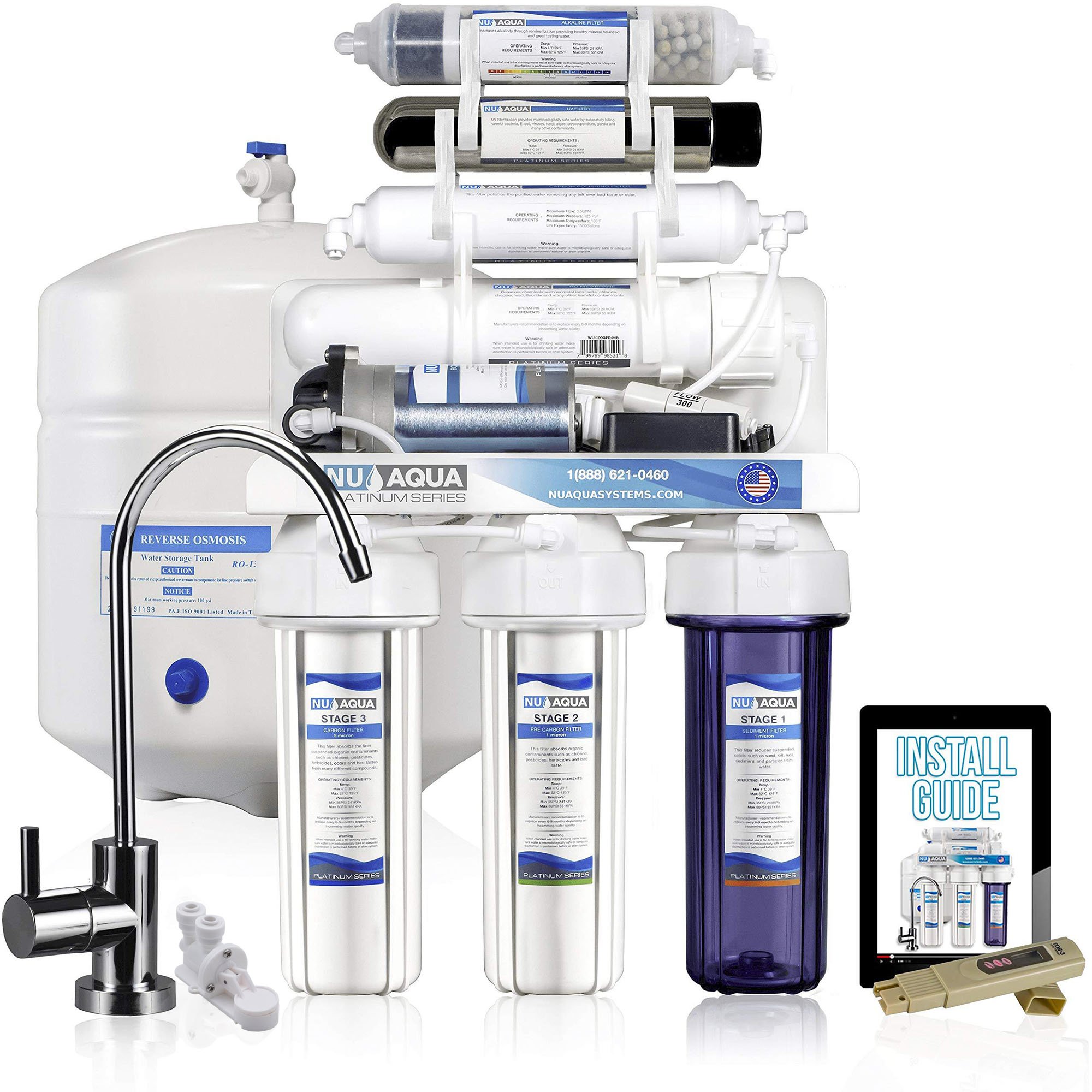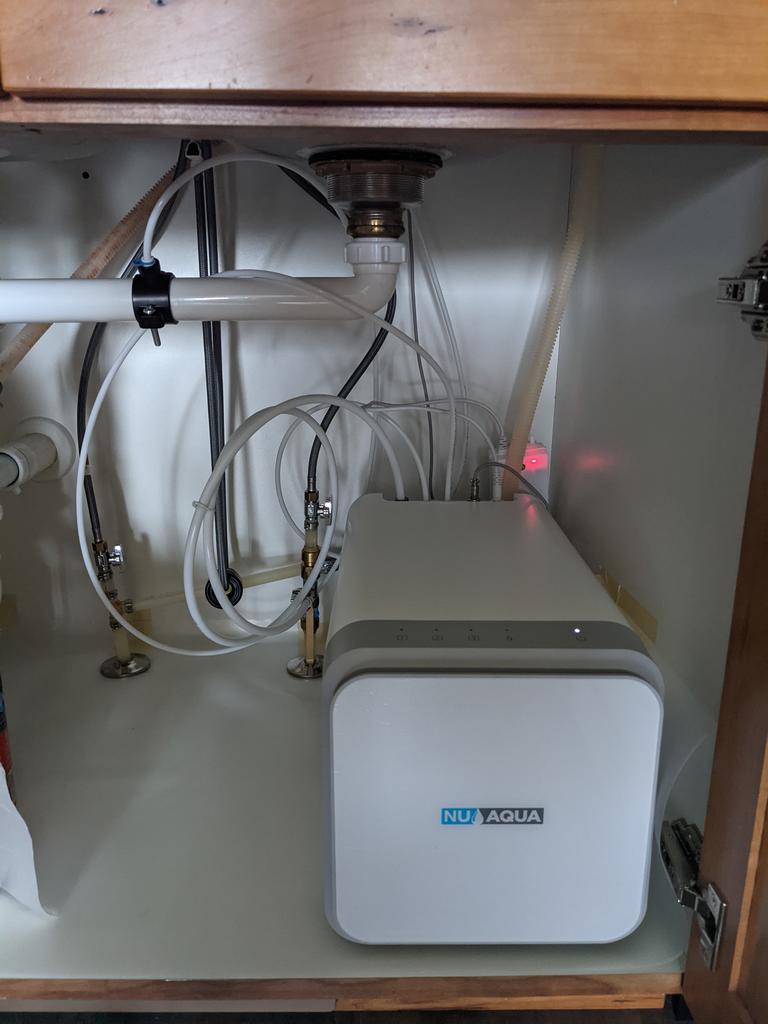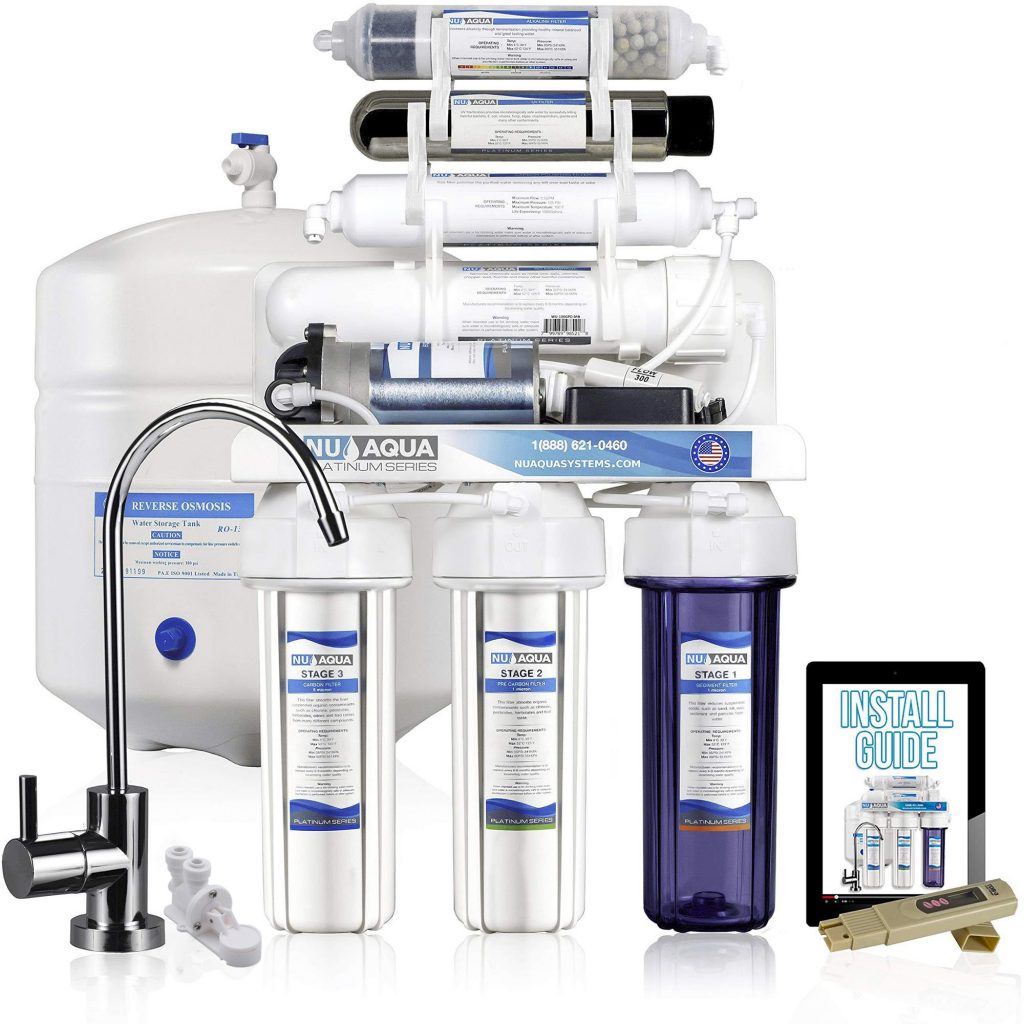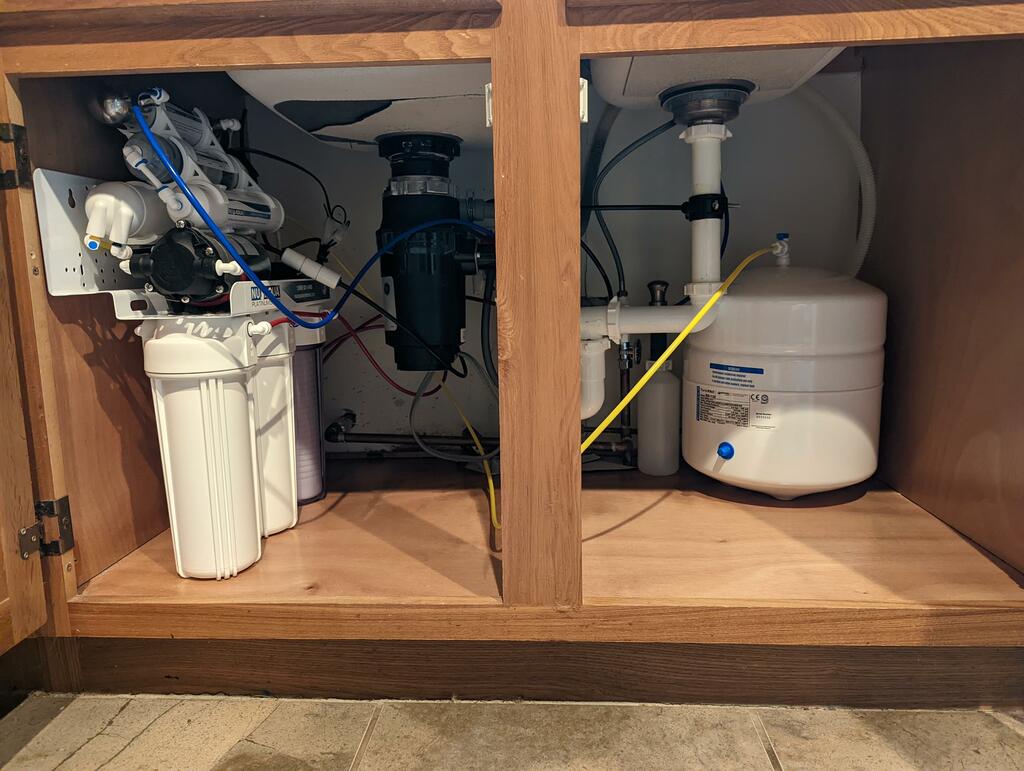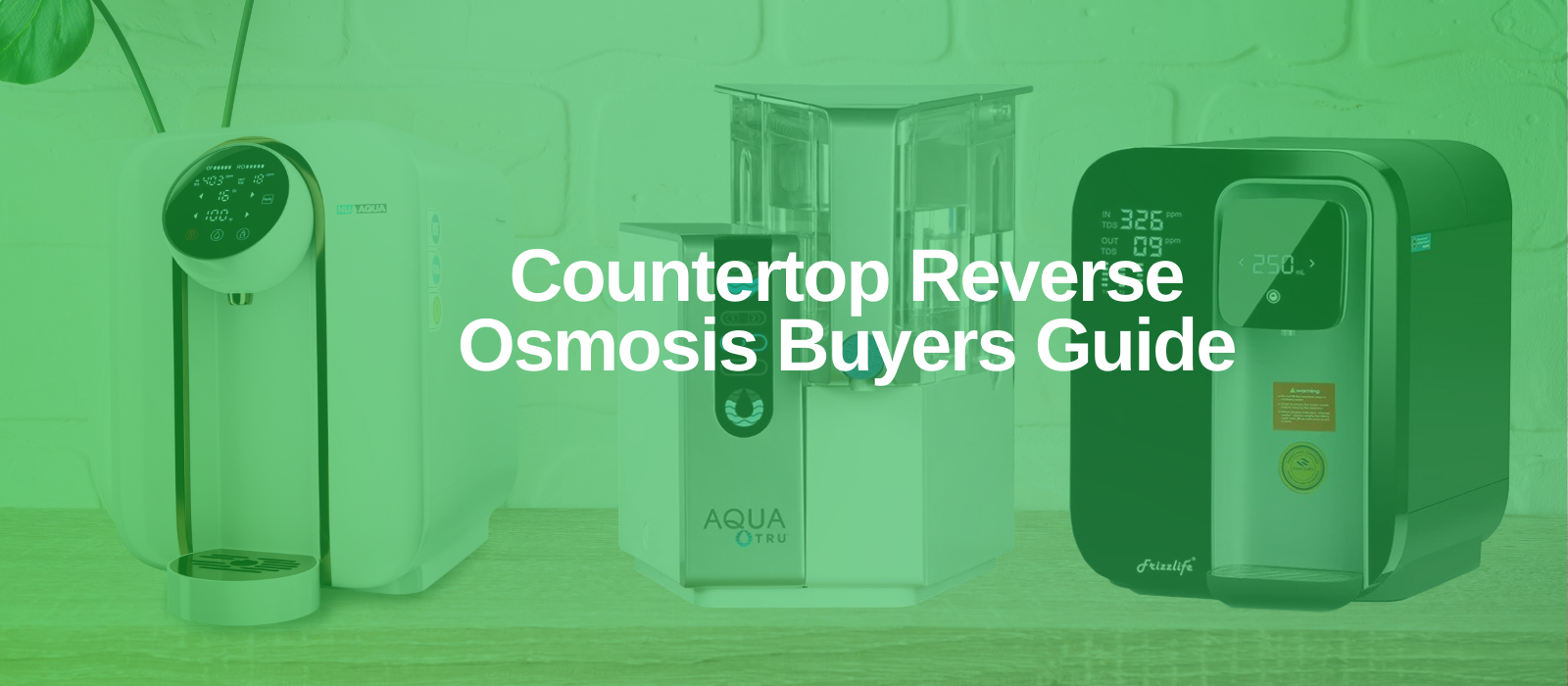Best Reverse Osmosis Systems Of 2022
Reverse Osmosis Water Filters are an effective and affordable way to purify your tap water. They let you drink healthy, clean drinking water in your home so that you can avoid buying bottled water, cut down on plastic waste, and save money. Reverse osmosis water filters are a great option for you if you want to enjoy healthy drinking water at the convenience of your home!
Reverse Osmosis Water Filters remove harmful contaminants from your tap water including chlorine and other chemicals as well as metals like lead and mercury. They also reduce health concerns such as bacteria, viruses, and microorganisms.
Here at WaterSpecialists.org we firmly believe that everyone deserves affordable, clean drinking water. The research can be a daunting task browsing through hundreds of systems, trying to compare their features and find out what system best fits your household’s needs. This is why we’ve taken time to thoroughly research and review the top reverse osmosis systems so that you can find that perfect system for you in minutes.
- Stages: 9 Stages
- Flow Rate: 600GPD
- Efficiency: 2:1
- Dimensions: 27 x 16.9 x 13.7 inches
- Replacement Indicators: Yes
- Highlights: 120 Day Trial, 5 year Warranty, Optional Alkaline Filter
- Stages: 7 Stages
- Flow Rate: 100GPD
- Efficiency: 1:2
- Dimensions: 15″ x 5.25″ x 19.5″
- Replacement Indicators: No
- Highlights: 120 Day Trial and 5 year Warranty
- Stages: 5 Stages
- Flow Rate: 400GPD
- Efficiency: 1:1
- Dimensions: 8.1 x 5.7 x 17.8 inches
- Replacement Indicators: Yes
- Highlights: TDS Meter On System
- Stages: 7 Stages
- Flow Rate: 600GPD
- Efficiency: 1.5:1
- Dimensions: 15.5″ x 5.3″ x 14.7″
- Replacement Indicators: Yes
- Highlights: TDS Display and alkaline filter
- Stages: 6 Stages
- Flow Rate: 75GPD
- Efficiency: 1:3
- Dimensions: 15″ x 5.25″ x 17.5″
- Replacement Indicators: No
- Highlights: Assembled In USA, NSF & WQA certified
1. NU Aqua Alkaline Efficiency Series Tankless 600GPD
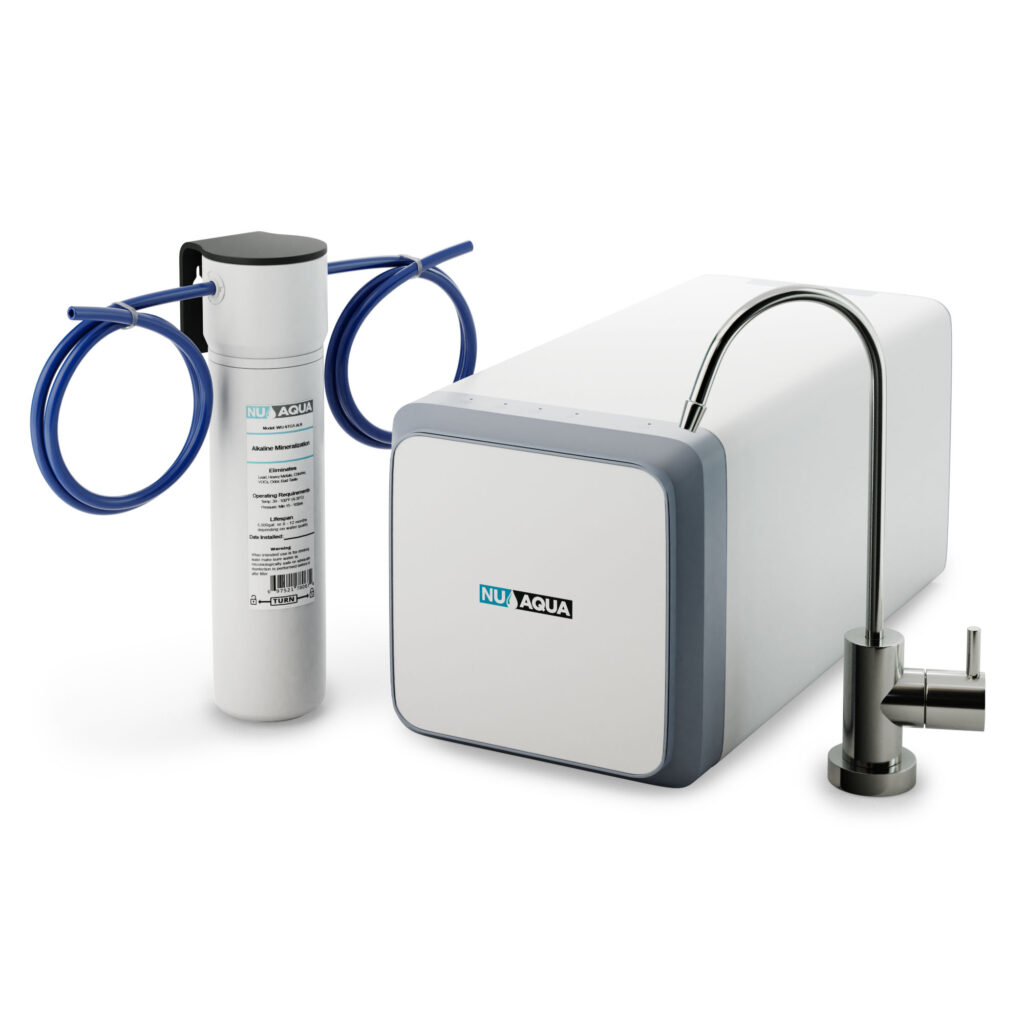
NU Aqua’s latest contribution to the industry is their efficiency series and the name says it all. This tankless reverse osmosis system produces 2 gallons of pure water for every gallon wasted. This is nearly double the efficiency of comparable systems. On top of that it provides 600 gallons per day which is enough water for just about every household size.
The system features a sleek minimal design that will not compromise the space under your sink like traditional RO systems with tanks. The front-facing panel is removable and is where you access your filters. This makes filter changes much easier when compared to traditional systems with canisters that require disassembling the filter housings and often makes a mess. With this system just twist the old filter, pull it out, and slide in your new filter.
What I Like About The NU Aqua’s Efficiency series?
Quick Change Filters
One of the features I love about this system is the quick change filters. Within a few seconds you can easily swap out any of the filters that need to be replaced.
No need to turn off your feedwater valve like traditional systems. The NU Aqua Efficiency series is truly a smart system. As soon as you twist the filter it automatically shuts the water off, preventing any leaks or spills.
The amount of time and effort this saves you when doing filter changes is one of the best features I personally enjoy about this system
Ultra Efficient & High Flow Rate
Besides the high flow rate and 2:1 pure to waste ratio, NU Aqua offers a 5 year warranty on all their systems, a 120 day 100% money back guarantee. This is a lot of confidence they put in their products.
The system features an internal booster pump so you don’t have to worry if you will have high enough water pressure. Only when the system occasionally flushes or when you draw water from the faucet will the pump turn on.
Smart Faucet & Filter Indicators
With the latest trend of everything being smart, this system features a faucet that indicates water quality or the need for filter changes by a blue and red light. Located on the system it has individual filter replacement reminders for each of the three filters. No more keeping a filter log under your cabinet or trying to guess the last time you changed your filters.
- 120 day guarantee
- 2:1 Waste Ratio
- 5 year warranty
- Filter reminders
- Smart faucet
- 36 month membrane lifespan
- Replacement filters not universal
- No TDS reading
- Price
2. NU Aqua 7 Stage Alkaline and UV with Pump
This traditional style reverse osmosis system features 7 stages of filtration. 11 Stages if you count the stages in the alkaline mineral filter. No matter your water quality this system is powerful enough to tackle some serious contaminants. If you’re on well water don’t worry, the UV sterilizer on this system has you covered and will kill bacteria, viruses, and other living organisms that come with well water.
Unlike most reverse osmosis systems with tanks, the NU Aqua 7 Stage has a 100 gallon per day capacity. The higher flow rate is great because it helps increase flow rate and supplies plenty of water for most home needs.
What I Like About the NU Aqua 7 Stage?
Most Features For The Price
Besides the systems performance it’s also a great value. This is one of the lowest priced systems that include a booster pump, uv sterilizer, and alkaline filter.
Ultra Quiet Booster Pump
One concern we have with systems that have booster pumps and tanks is the noise. Since the system takes time to fill the tank the booster pump must run and it having to hear the pump can get annoying. But with this system that’s not the case. The booster pump on the NU Aqua 7 stage is completely silent leaving you wondering if it’s even running at all.
Great For Well & City Water
Overall this system is a great option for homes on well water or those who have low water pressure. Just like NU Aqua System’s tankless system, this comes with their 5 year warranty and 120 day 100% money back guarantee.
- 120 day guarantee
- 5 year warranty
- UV sterilizer
- Alkaline mineral filter
- Silent booster pump
- Great value
- More complicated than other system due to more stages
- More filters to replace
- Not NSF
3. Waterdrop G3 400GPD Reverse Osmosis System
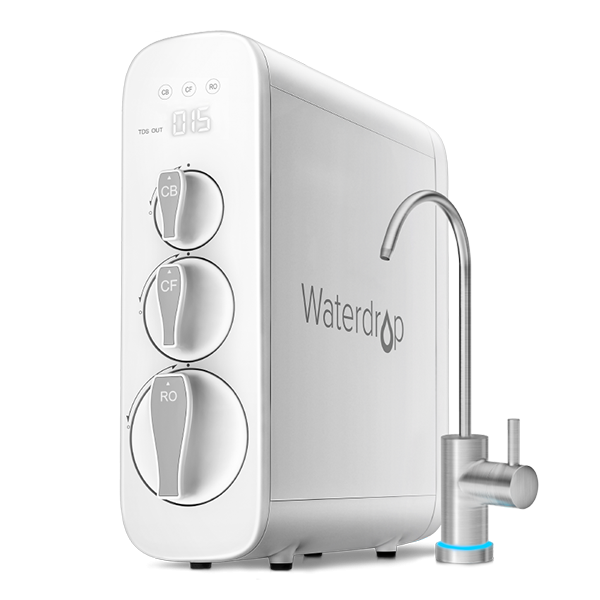
Don’t let it’s size fool you, the Waterdrop G3 is a feature packed system in a little package. This system has all the bells and whistles to make owning a reverse osmosis system as pain free as possible all while providing a high flow rate of 400 gallons per day which is more than enough for most homes.
This systems narrow design helps it fit under most sinks and the front facing filters makes changing them nothing to dread.
What I like About The Waterdrop G3 system?
Besides it’s small footprint, the system has a build in TDS meter located on the front of the system. This allows you to check the quality of your water and filters in seconds. The smart faucet included with this system can indicate the condition of your water. Blue for perfect, yellow for needing replacement soon, and red for replace now.
Aside from the smart technologies this system is tankless and rated up to 400 gallons per day. Which can easily provide enough water for just about any sized home.
- Smart faucet
- TDS monitor on system
- Filter reminder
- Easy filter replacements
- Higher price than comparable systems
- Expensive replacement filters
4. Frizzlife PD600 With Alkaline Remineralization
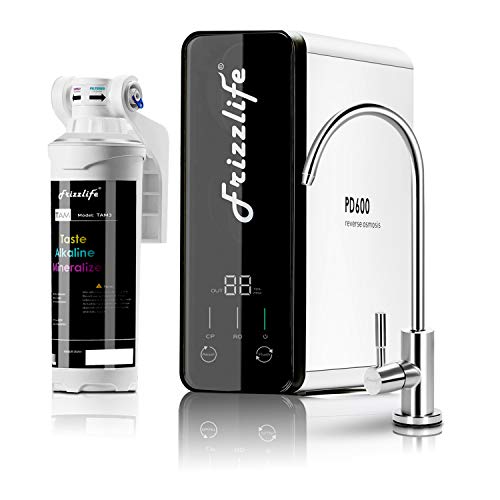
The Frizzlife PD600 is a compact tankless reverse osmosis system with lots of features. This system is rated for 600 gallons per day at a 1.5:1 pure to waste ratio. This is a very efficient system that’s able to supply more water than most households will need.
This system does not include a smart faucet but the system has a front facing TDS display and filter life indicators. This helps you monitor the remaining life of each filter.
The two filter in the system are front facing and easily replaced in seconds. The third alkaline mineral filter in included with the system is external and installs inline before your faucet.
What I Like About The Frizzlife PD600?
It’s not the most affordable system on our list but it’s features certainly set this system apart. Since most tankless systems do not feature an alkaline stage the addition of this really makes it a great option for those who want less acidic water but also want the convenience and features that come with a tankless system.
Instead of using multiple filters, the Frizzlife PD600 only has two filters that have multiple stages. This helps cut down on replacement costs and the frequency you need to replace them.
- Easy to replace filters
- Filter life indicators on system
- Alkaline remineralization
- TDS reading on system
- More complicated install with external alkaline filter
- Filter not universal
- Expensive replacement filters
5. APEC Essence Series Alkaline ROESS-PH75
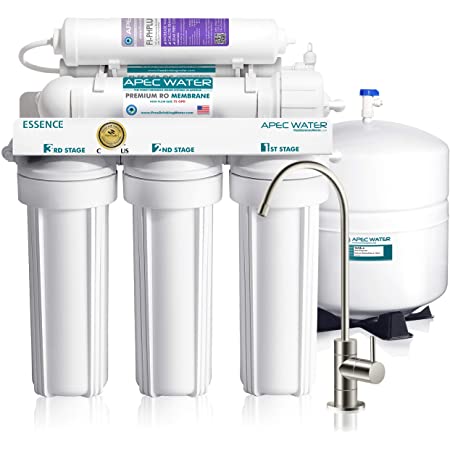
APEC is one of the more established brands on our list. They’ve been around for 20 years and are known for their quality and support.
This is a 6 stage system that features a 75 gallon per day that can remove up to 99% of viruses, bacteria, cysts, and organic chemicals.
What I Like About The APEC Essence Series ROESS-PH75?
What really stands out about APEC is that their systems are assembled and tested in the United States. This helps reduce the chance of loose fittings and prevents leaks. This added comfort does come at a price which is why APEC tends to be more pricey.
The carbon block filters in this system are rated up to 12 months which is double the life of most carbon block filters used with these style of systems.
- Long lasting carbon block filter
- Alkaline filter
- WQA certified
- Assembled and tested in the U.S.
- Higher price point
- Lower flow rate than other systems
Undersink Reverse Osmosis Buyers Guide
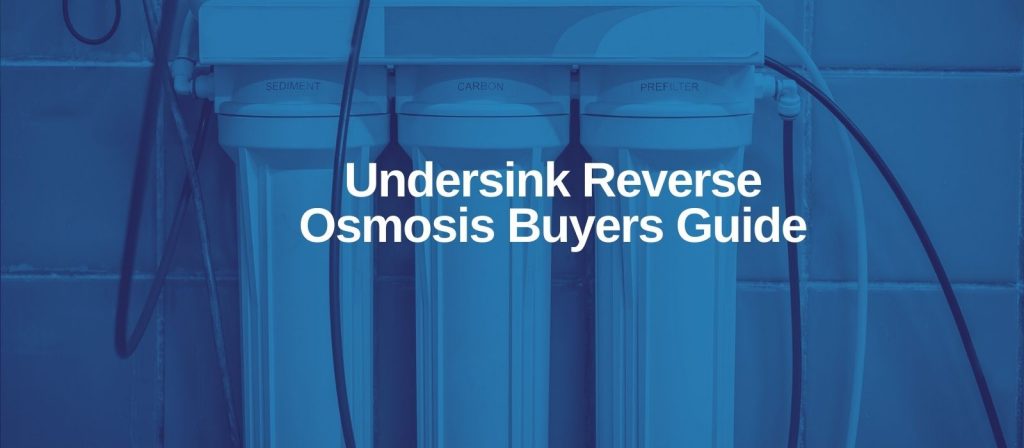
If you’re in search of a reverse osmosis filter system for your home you’re already taking the first steps to improving your water quality and taking your health serious. If you’ve never owned a system this guide is intended to provide you all the necessary information help you understand how reverse osmosis works and everything you need to know.
What is a reverse osmosis system?

Reverse osmosis systems feature a series of filterers in stages and a membrane. The system will operate using your existing water pressure to force the water through the different filters of the system before the membrane. The membrane is semi-permeable with an extremely small pore size. When water is forced through the membrane contaminants are rejected and flushed as waste. The purified water is then sent to a storage tank or directly to your faucet if the system is tankless.
What are the components of a reverse osmosis system?
The first stage of filtration in a reverse osmosis system is a sediment filter. Sediment filters remove the larger contaminants that are visible within your water such as rust, dirt, sand, and dust. Sediment filters will vary in micron, which is the size of the molecule that it will prevent from passing through the filter. For example, a 5-micron sediment filter will block anything 5 microns or bigger but will allow particles 4 micron or smaller to pass through. The smaller particles are removed later by carbon filters or the reverse osmosis membrane.
Granular activated carbon filters are commonly used as the second stage in most reverse osmosis systems. The filter is filled with small, loose granules of carbon which is often made from coconut shells or coal. This increase the surface area of the carbon which allows for a higher absorption of contaminants. These filters are great at removing organic chemicals, odors, and bad taste.
Carbon block filters are often used in the 2nd and third stage of a reverse osmosis system. Unlike granular carbon filters where the carbon is loose, these filters are a solid block of carbon. Carbon block filters can easily remove a lot more contaminants than just chlorine from water, such as lead and other metals. Higher quality carbon block filters will remove many pollutants including arsenic, mercury, asbestos and radon.
The reverse osmosis membrane of an RO system is where a lot of the heavy lifting is done. The membrane pore size is typically around 0.0001 micron which smaller that salt, bacteria, and viruses. Reverse osmosis membranes are highly effective at removing chloride, copper, sodium, lead, fluoride, radium, sulfate, calcium, magnesium, potassium, chromium, nitrate, and phosphorous.
After the water is processed by the membrane it’s sent to the storage tank. Storage tanks are used on traditional style reverse osmosis systems and allow systems with lower flow rates to provide water at a higher flow rate when needed. These tanks fill with water and have a pressurized bladder that increases the water pressure at the faucet.
After the storage tank the water is typically sent through a final carbon post filter where any remaining bad taste or odor is removed.
Some systems will have an optional ultraviolet sterilizer or alkaline after their post filter. Ultraviolet is a great option for homes that are on well water that has not been chlorinated to kill microorganisms, bacteria, and viruses.
When it comes to alkaline filters it’s preference. It’s a common misconception that drinking RO water is unhealthy because it’s been stripped of it’s minerals. When in fact you receive your receive your daily required minerals from the food you eat and minerals in water are hardly retained by your body. However, the added minerals are a benefit but not necessary. They also tend to improve the waters taste.
What does a reverse osmosis system remove from water?
Arsenic (pentavalent), Barium, cadmium, Chromium (hex), Chromium (tri), Copper, Fluoride, Lead, Radium 226/228, Seleniun, radium, sulfate, calcium, magnesium, potassium, nitrate, and phosphorous
How much water does reverse osmosis waste?
There is a big misconception about reverse osmosis system and how much water they waste. It is true that they waste water and that’s how they operate to provide such pure water. The membrane must use water to flush away the contaminants and brine.
Older style reverse osmosis systems used to was as much as 4 gallons for each gallon of pure water they produce. That’s not the case anymore. Modern reverse osmosis systems with tanks can be as efficient as 2 gallons of waste for every gallon produced. While that may sound like a lot of water it’s much less than it sounds. Let’s look at other appliances we use and how much they waste. A 10 minute shower will use approximately 25 gallons of water, a flush of a toilet is 1.6 gallons, and your dishwasher uses 3 gallons per load.
So if you’re filling your systems tank at a waste ratio of 1:2 it will waste approximately 10 gallons to fill a 5 gallon tank. Most homes will not drink more than 5 gallons a day so the amount waste may be 10 gallons every 2-4 days. With the average cost of water at your home being less than a penny this is drastically cheaper than purchasing water even with the waste.
If waste is a big concern for you tankless system might be the right option for you. Some of the best tankless systems waste only 1 gallon of water for every 2 gallons of pure water produced. This systems are highly efficient, require no tank and always have water on demand.
What to do with reverse osmosis waste water?
Wash your car
When you wash your car it consumes a lot of water and any way we can help minimize or waste is always important. Washing your car with the waste water produced from your system is a great way to re-purpose your water and won’t harm your car’s paint.
Water your garden
If you have a garden or just a few potted plants around your house the waste water from your system is perfect. Since the waste water has high TDS and minerals it will be beneficial for them.
Chores around the house
If you mix your own cleaning solutions at home or need to mop your floors the waste water from your system works great for all cleaning applications.
What is the lifetime of a reverse osmosis water filter?
Each filter in a reverse osmosis system will have a different life span.
Systems with tanks:
- Sediment Filter: 6-9 months
- Granular Carbon Filter: 6-9 months
- Carbon Block Filter: 6-9 months
- Reverse Osmosis Membrane: 1-2 years
- Carbon Post Filter: 6-9 months
- Alkaline Filter: 1 year
- UV Bulb: 1 year
Tankless systems:
- Sediment Filter: 6-12 months
- Carbon Filter: 6-12 months
- RO Membrane: 2-3 years
Since tankless systems use proprietary filters the lifespans above are a generalization. Each manufactures filter lifespan will vary.
How much does a reverse osmosis water filtration system cost?
The costs of owning a reverse osmosis system has come down drastically over the passed decade. No longer does the cost of replacement filters off set the savings from purchasing bottled water. Systems and their replacement filters are much more affordable now.
Most undersink reverse osmosis systems with tanks will range in price starting from $170 to $300 depending on the system. The more stages the system has, like UV or alkaline will increase the price. Also, if the system has a booster pump they will be more expensive. A full set of replacement filters for these systems including the membrane will range from $50 to $100.
When it comes to tankless reverse osmosis systems they are a little more expensive, but that’s due to having more technology and larger filters. Most tankless systems range from $350 – $550 and a full set of replacement can go for $80 to $150 depending on the system.
How to choose the right system gallon per day RO system?
When it comes to choosing the right RO system, a big contributing factor is choosing the right flow rate. The membrane in every reverse osmosis water filter system is going to be the bottleneck of the system as it’s the slowest stage of the system to process water. When you see a system and it’s 100GPD this means the membrane has a flow rate of 100 gallons per day.
The most common membrane flow rate is 50 gallons per day which is sufficient for a small home of 2-3 people. If your household is larger than 3 or use a lot of water whether is drinking or cooking it’s best to go with a 75 or 100 gallon per day system. This ensure you always have pure water ready to go. A 100 gallon per day system can easily support a home of 6+ people.
Lastly we need to address tankless reverse osmosis systems. These systems often have 300, 400 or even 600 gallon per day membranes. This is because the system does not use a tank and the system needs to process purified water at a fast rate to have high water pressure at the faucet. These system are great for any household size since you do not have to wait for a tank to fill, this is one of the great benefits of a tankless system.
Do I need a reverse osmosis system with a booster pump?
The biggest determining factor for whether or not you need a booster pump for your reverse osmosis system is water pressure. A system without a pump will work with water pressure between 40-80PSI. The lower your water pressure the less efficient the membrane will work and can lead to your system being more wasteful. Ideally you should have 60+PSI for your system to operate most efficiently.
Generally speaking homes that are supplied water from the city have around 60PSI but there are a few factors that can lower your water pressure.
- City has implemented regulations
- Main water shutoff valve not fully open
- Failing pressure regulator
- Clogged pipes
- Excessive corrosion on pipes
- Installation location above the first floor
- High rise apartment building
Now if your water source is from a well it’s possible your water pressure is below 40PSI. This is when a booster pump should be used to ensure your system runs as efficient as possible. If you’re not sure what your water pressure is learn how to check your water pressure below.
How to check your home water pressure?
If your planning to install a reverse osmosis system but think your homes water pressure is on the lower side it’s best to check your water pressure before hand so you can purchase the right system.
To test your water pressure you’re going to need a pressure gauge. These gauges can be purchased from any hardware store. These gauges are inexpensive and spending the money not to test your water pressure will save you money and a headache in the future.
- Hook the pressure gauge up to either hose connection outside your house or a faucet.
- Make sure all showers, dishwasher, faucets, and other appliances that use water are turned off.
- Fully open the faucet or valve you’ve installed the pressure gauge and check the reading. Ideally you would like to see your pressure above 40PSI.
Do I need a reverse osmosis system with alkaline?
While doing your research on the perfect reverse osmosis system for your home you will most likely see systems offered with an optional alkaline filter. These filters feature natural minerals that raise the PH of the water and add back beneficial minerals that have been stripped from the water during the filtration process?
There are many misconceptions about reverse osmosis water being unsafe because the minerals have been taken out. Some claiming it’s dead water. But in fact the amount of minerals your body can retain from drinking water is so low it does not have an affect on your health. We receive all the minerals we need from our diet.
However, if you’ve ever looked at a bottle of water you will notice they all say “processed by reverse osmosis”.
Why do different bottled water brands taste different from one another?
After bottled water companies process the water by reverse osmosis, they add back minerals to the water for taste. This is how each brand has their unique taste.
When it comes to deciding if you want the optional filter, it really comes down to taste. Lot’s of people prefer reverse osmosis water exactly how it comes from the system and think it’s even better than bottled water. But ultimately it’s preference and everyone taste preference varies. If you purchase a system that does not include an alkaline filter and do not like that taste, don’t worry. You can easily add one later if you would like to try it out.
Do I need a reverse osmosis system with a ultraviolet (UV) filter?
Having the extra ultraviolet filter on your system definitely gives you peace of mind but depending on your water source it may be a little overkill.
The water that homes receive from the city comes pretreated. Water treatment facilities chlorinate water as a way to kill parasites, bacteria, and viruses. While this does a great job of ensuring are water is safe from these contaminants, many people do not want to drink chlorinated water. This is why many choose to install a reverse osmosis system.
Homes that receive their water from a well do not have the same luxury. Their water is straight from the source and much more susceptible to microorganism contaminants that can make you sick. This is where an ultraviolet filter is most needed. Not all wells are contaminated, but they are also easily affected the nearby environment such as waste from a farm, or mine, and pollution.
Overall if you’re on well water and do not have a whole house sterilizer installed, you need to have a UV filter to ensure your water is safe to drink. If you’re on city water the choice is optional.
Ben Jordan has over 10 years of experience working in the water treatment industry and has a bachelors degree in water management. Water is his passion and in his free time he’s an aquarist that maintains large saltwater aquariums.

